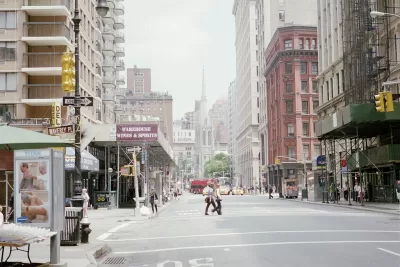"Rather than serving as a buffer against economic decline for independent retailers, it seems that Community BIDs are a hindrance to sales and employment growth..." writes Dr. Stacey Sutton in the Journal of Planning Education & Research.

After the large scale abandonment of central cities in the 1950s-1970s, many urban municipalities lacked both vibrancy in their commercial districts and resources to reinvest in better urban infrastructure and security. Business Improvement Districts (BIDs) emerged as a strategy to help stem the decline of these districts by using special self-taxation powers to finance street upgrading, beautification, and increased security, among other industry-driven services. However, given the costs to businesses from the additional tax burden in BIDs, it is only natural to ask if they are justified by their benefits in terms of economic development.
In a recent article in the Journal of Planning Education and Research, "Are BIDs Good for Business? The Impact of BIDs on Neighborhood Retailers in New York City," Columbia University's Stacey Sutton asks just this question for the United States' largest city (Click the link for Open Access). The study differentiates large scale corporate BIDs, like the one which exists in Times Square, with Destination Bids, existing on important commercial corridors, and smaller Community BIDs, which cover neighborhood level retail corridors. Community BIDs are smaller and “...focus on district maintenance, upkeep, and retention of existing businesses rather than capital improvements or even security...,” (Sutton 2014) which are stalwart elements of larger BIDs. The Community BIDs grew rapidly in number during the 2000s, and these, along with the mid-size Destination BIDs are the focus of Sutton's study.

Sutton uses statistical matching techniques to compare the performance of NYC BIDs formed between 2002 and 2008 to other similar areas of the city that had not established BIDs. Matching is like a quasi-experiment. It allows a researcher to evaluate a policy intervention by comparing observed outcomes to what we might expect had the policy not been implanted. Here, Sutton used “retail firm, neighborhood, and building attributes” prior to BID formation as primary criteria for creating matched pairs. The idea is that the propensity score matching method will incorporate the most important observable factors related to retail firm performance, and create a balanced set of control districts to compare with those that entered BIDS pre-and-post creation.

The economic development outcomes that Sutton tested included employment growth and the rate of change of retail sales as measured in the National Establishment Time Series data set. Sutton found that BIDs are more likely to be established in areas “with higher retail density, assessed property values, dense population, and college-educated residents”. BIDs are less prevalent higher income areas, and in areas with large White or foreign born populations.
Somewhat surprisingly, Sutton found that when examining neighborhood retail, sales and employment both declined in small Community BIDs versus the matched non-BID areas, but larger Destination BIDs perform better than comparable areas of the city. This may have been because small BIDs tend to attract small independent retailers, who on average have lower sales volumes and employment than do larger retailers, and they are more susceptible to broader economic shifts. The effects of medium-size BIDs was different. In these larger retail corridors employment and sales increased. This may have to do with the fact that these areas tend to attract large and more stable businesses able to pay higher rents. Sutton concludes that BIDs may not always be the best policy for areas with significant levels of independent retail.
The study also finds that in areas of the city with greater growth in independent businesses, both sales and employment decline significantly. All of this suggests that policy makers should tread lightly when promoting BIDs as a solution for urban economic development, especially in areas of significant independent retail presence.
Full text of the Sutton article is available here in HTML format and here in PDF format until October 25, 2014.
Blog Post by Thomas Douthat and Dr. Stacey Sutton
Follow JPER on Twitter @JPER7.

Planetizen Federal Action Tracker
A weekly monitor of how Trump’s orders and actions are impacting planners and planning in America.

San Francisco's School District Spent $105M To Build Affordable Housing for Teachers — And That's Just the Beginning
SFUSD joins a growing list of school districts using their land holdings to address housing affordability challenges faced by their own employees.

The Tiny, Adorable $7,000 Car Turning Japan Onto EVs
The single seat Mibot charges from a regular plug as quickly as an iPad, and is about half the price of an average EV.

Seattle's Plan for Adopting Driverless Cars
Equity, safety, accessibility and affordability are front of mind as the city prepares for robotaxis and other autonomous vehicles.

As Trump Phases Out FEMA, Is It Time to Flee the Floodplains?
With less federal funding available for disaster relief efforts, the need to relocate at-risk communities is more urgent than ever.

With Protected Lanes, 460% More People Commute by Bike
For those needing more ammo, more data proving what we already knew is here.
Urban Design for Planners 1: Software Tools
This six-course series explores essential urban design concepts using open source software and equips planners with the tools they need to participate fully in the urban design process.
Planning for Universal Design
Learn the tools for implementing Universal Design in planning regulations.
Smith Gee Studio
City of Charlotte
City of Camden Redevelopment Agency
City of Astoria
Transportation Research & Education Center (TREC) at Portland State University
US High Speed Rail Association
City of Camden Redevelopment Agency
Municipality of Princeton (NJ)



























